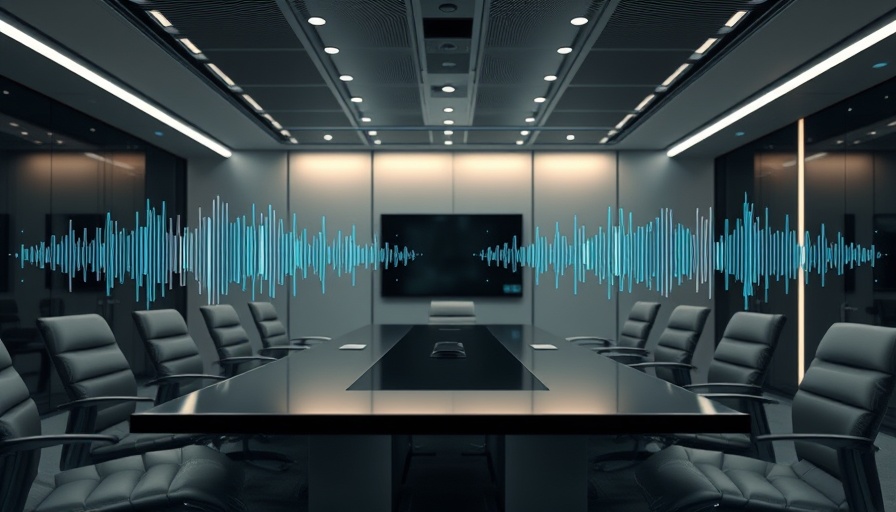
Understanding Speaker Diarization: A Gateway to Clarity
In today's fast-paced digital world, clear communication is paramount, especially for small and medium-sized businesses (SMBs) that thrive on effective information exchange. Speaker diarization, a technology capable of distinguishing different speakers in conversational audio, is revolutionizing how audio data is analyzed. By answering the pivotal question of "who spoke when," this technology enhances the quality and utility of transcriptions, making them clearer and more searchable. For SMBs navigating environments like call centers, legal dilemmas, or collaborative meetings, adopting such advanced audio analytics can significantly improve operational efficiency.
How Does Speaker Diarization Work? The Tech Behind the Process
At its core, speaker diarization is built on stages, each interconnected to ensure accurate results. The process involves:
- Voice Activity Detection (VAD): This first step filters out silence and background noise, letting only relevant speech pass through for further analysis. High-quality VAD systems trained on diverse data sets ensure performance even in challenging acoustic environments.
- Segmentation: Continuous audio is split into manageable speech utterances, crucial for subsequent processing. Sophisticated models now dynamically detect speaker turns, minimizing issues like fragmentation common in traditional methods.
- Speaker Embedding: Modern technology converts audio segments into fixed-length vectors, capturing unique vocal characteristics. Systems that are trained on extensive multilingual corpora are especially beneficial, enabling them to adapt to varied accents, which is essential for businesses operating in diverse markets.
- Speaker Count Estimation: This innovative approach allows systems to either determine the number of speakers or adapt clustering without prior knowledge, enhancing flexibility for real-time applications.
- Clustering and Assignment: This final step groups the processed audio based on similarities, applying techniques such as spectral clustering to ensure accurate speaker identification.
A Brief Look at Accuracy and Challenges
While speaker diarization holds considerable promise, achieving accuracy is a notable challenge. Industry standards currently define a Diarization Error Rate (DER) under 10% as acceptable for production use, although this can vary across different applications.
Critical hurdles include:
- Overlapping Speech: When speakers talk simultaneously, systems struggle to correctly attribute segments to the right speaker.
- Environmental Noise: Background sounds can distort audio clarity, impacting transcription accuracy.
- Variability in Speaker Characteristics: The technology must continuously adapt to different voices, accents, and styles to maintain reliability.
Trends & Future Directions in Speaker Diarization
As we look forward to 2025, several trends in speaker diarization are emerging, driven by advancements in artificial intelligence and machine learning. These innovations promise to enhance the effectiveness of audio analytics further:
- Real-Time Processing: Increased computational power is leading to more efficient real-time applications, beneficial for dynamic environments like online meetings and podcasts.
- Advanced Algorithms: The use of deep learning techniques will continue to improve speaker identification accuracy across diverse contexts and languages.
- Enhanced User Interfaces: As more SMBs adopt diarization technology, there will be a push for user-friendly interfaces that allow non-technical users to harness these sophisticated tools easily.
- Integration with Other Technologies: Expect to see speaker diarization being integrated into customer relationship management (CRM) systems and other business tools, further optimizing workflows.
Key Libraries and APIs: Navigating Your Options
When selecting a speaker diarization solution, consider well-regarded libraries and APIs that cater to the specific needs of SMBs:
- Pytorch Speaker Diarization: This library leverages the Pytorch framework for enhanced deep learning capabilities.
- Kaldi: A long-standing open-source tool that provides a comprehensive toolkit for speech recognition and speaker diarization.
- Google Cloud Speech-to-Text: An API that offers robust speech recognition features, including diarization functionalities.
- AssemblyAI: Easy-to-integrate API with excellent outbound support, specifically tailored to enhance user experience.
These options solidify the foundation for businesses to find the right tools tailored to their specific needs.
The Value Proposition: Why Diarization Matters for SMBs
Investing in speaker diarization technologies can simplify business processes, enhance customer interactions, and provide valuable insights into communication patterns. For SMBs striving to optimize their operations, understanding and leveraging this technology can lead to:
- Better Customer Engagement: Clear, accurate communications improve customer interactions and satisfaction.
- Enhanced Operational Efficiency: Analyzing recorded interactions for insights supports decision-making and strategy improvement.
- Accessibility: By providing searchable and easily navigable transcriptions, speaker diarization ensures vital information is not lost.
Concluding Thoughts: Take Charge of Your Conversations
In today's data-driven landscape, adopting speaker diarization can place your business a step ahead. By ensuring clarity in conversations, SMBs can unlock new opportunities and thrive in ever-competitive markets. Are you ready to implement these technologies to transform your business interactions?
 Add Row
Add Row  Add
Add 



Write A Comment